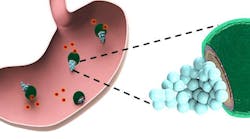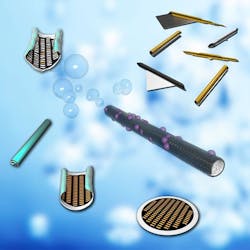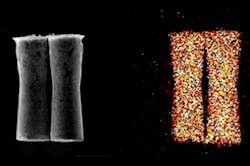Nano- and micromotors represent an emerging field of small scale, non-invasive medical intervention, medicine deployment, and health diagnostics encompassing everything from energy storage to environmental monitoring. Nano- and micromotors are often mimics of natural biological motors, reacting to the chemicals in our bodies as a fuel source.
There are a few hurdles that need to be addressed before these devices can become reliable medical tools, however. The fuels these motors typically run on are not wholly biocompatible. Manufacturing of these motors is another hurdle. Still, scientists are making strides on both fronts to pave the way for these delivery systems.
Scientists are perfecting the delivery systems and manufacturing process for nano- and micromotors to create a reliable medical delivery system.
What are Nano- and Micromotors?
Nano- and micromotors are small-scale devices that respond to specific stimuli and are designed to perform selected mechanical movements. These movements can vary depending on the design and its biologically or chemically functionalized components. Their movements include rotation, rolling, shuttling, delivery, contraction, or specimen collection behavior. These devices are fueled by different energy sources, such as fuel (natural or synthetic) or a physical source such as light, magnetic and electric fields, or ultrasonic acoustic waves.
The interest in these devices has grown over the last 10 years, with research progressing into specific applications such as biomedicine (e.g., diagnostics), environmental monitoring and remediation, food safety, and security. In the future, scientists hope micromotors could be used to deliver drugs to specific areas of the body, repair damaged tissues such as blood vessels, and even manipulate individual cells.
First Deployment in Living Tissue
The first successful deployment of micromotors in living tissue was used on mice in 2015.
In 2015, a group of scientists from the University of California, Berkeley successfully deployed micromotors for the first time through the body of a living animal—successfully delivering a cargo of nanoparticles directly into the stomach wall. They suggested the motors could potentially be an ideal candidate for a novel gastric drug delivery system, such as their unique acid-powered propulsion and autonomous release of cargo.
The scientists tested the micromotors inside mice. For the study, the researchers designed a type of micromotor powered via an acidic solution. They coated polymer tubes, just 20 micrometers long and 5 micrometers wide, with zinc. The zinc reacts to the acid, generating bubbles of hydrogen which are forced out of one end of the tube, propelling it through the acid.
The scientists loaded the motors with a test cargo of gold nanoparticles and fed them to mice. To compare the results, they also had a group of control mice, which they fed only the gold nanoparticles without the motors. The studied showed that the motors could propel themselves fast enough through the stomach acid to lodge in the mucus lining and deliver the payload. The control group did retain the gold nanoparticles in their stomach linings. The group which received the motors possessed three times as many gold nanoparticles, suggesting a superior delivery system.
According to the team, these motors are ideal for use inside living organisms. Many of the motors still rely on chemical fuels such as hydrogen peroxide, which is potentially hazardous to the body. The new motors rely on different acidic fuel sources and self-destruct without leaving behind any residual toxic compounds.
A New Manufacturing Method
The use of graphene oxide in the production process for nano- and micromotors allows for uniformed shape production that can be replicated on a large production scale.
The latest developments in nano- and micromotors involve their manufacturing process. Researchers of the ICN2 Nanobioelectronics and Biosensors Group led by Professor Arben Merkoçi have devised a simple manufacturing method for graphene oxide-based micromotors. The motors developed have been used in test conditions to remove oil droplets from water.
The newly developed graphene motors are impressive due to their simple production method. By adapting an existing in-house technology, a graphene oxide solution is poured onto a wax-printed paper membrane. Acting as a mold, when wetted and hand-shaken from side to side in ethanol, it sets and releases multiple self-rolled graphene oxide tubes, forming the basic building blocks of the micromotors. These roll-up micromotors can then be lined with platinum. When the motors are released into their task, a small quantity of hydrogen peroxide is added. The platinum reacts the hydrogen peroxide, creating bubbles to generate forward motion. The motors can also be lined with magnetic particles that can be controlled via magnets.
The process developed at the ICN2 is cheaper and simpler than existing methods for produce micromotors and requires no special equipment. The new process offers greater control over the direction in which the graphene oxide rolls up. Micromotors can exhibit different behaviors as they movie through a liquid depending on how they are scrolled. Controlling the scrolling process is important for practical applications on a large scale, as researchers need to be able to produce batches of motors capable of performing the same task.
Along with working on different roll-up configurations, the scientists at ICN2 also tried varying the thicknesses of the scrolls and the reduction levels of the solution used to make them by decreasing the proportion of oxygen in the oxide. They could produce motors with different internal structures and surface characteristics, with the different solutions setting differently and/or scrolling tightly upon release from the membrane. These new variables offer researchers the ability to mechanically and chemically tune the micromotors for specific tasks.




